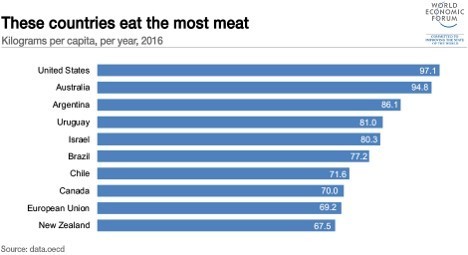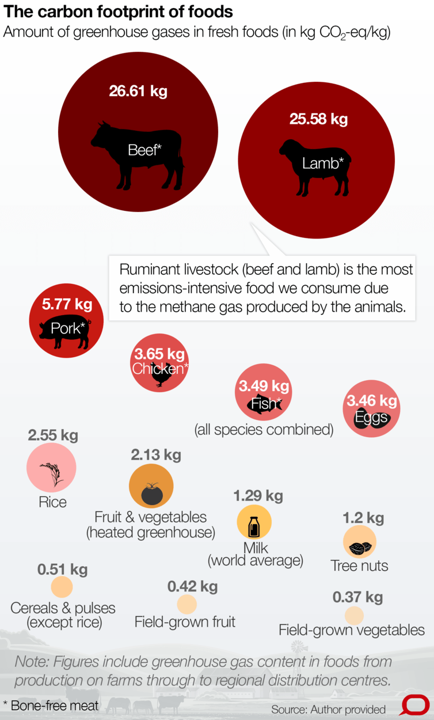Charting the World
These Are the Countries That Eat the Most Meat

Source:Shutterstock
Red meat production is a major contributor to global warming because of the methane emitted by cattle and sheep. Which countries eat the most meat? This chart tells you the top meat-loving countries in the world.
Views
These Are the Countries That Eat the Most Meat
By Rob Smithweb only
The Organization for Economic Cooperation and Development (OECD) is keeping tabs on the world’s meat-eating habits, regularly publishing data showing which of its member countries are the most carnivorous.
The 2016 figures, taken from the OECD-FAO Agricultural Outlook 2017-2026, include the weights of beef and veal, pork, poultry and sheep consumed per capita, which are calculated based on kilograms of retail weight (the weight at which the meat is sold).

The United States tops the list, with citizens eating an average of around 97 kg per year.
Australia, which consumed the most meat according to the same data from 2013, is in second place, at 2.3 kg less per person per year than the US.
Australian meat consumption, however, has increased from 93 kg per person to 94.8 kg, the OECD data shows. Australians also consume far more lamb than their American counterparts – eating an average of 8.6 kg per person versus 0.4 kg in the United States.
Argentina is in third place at just over 86.1 kg per person per year. The South American country is also the second biggest consumer of beef and veal (38.6 kg), with first place being awarded to neighbouring Uruguay, where citizens consume on average 43.1 kg of red meat per year.
The Carbon Footprint of Red Meat
Red meat production is a major contributor to global warming because of the methane emitted by cattle and sheep.
Field-grown vegetables, on the other hand, produce the least emissions, according to research published in the Journal of Cleaner Production.
For example, it takes about 50 onions to produce a kilogram of greenhouse gas, but only 44 grams of beef to produce the same amount.

Image: The Conversation
Lab-Grown Meat
Of course, it is plausible to substitute red meat with plant-based protein sources, such as lentils and nuts, that have a much smaller impact on the environment.
Or you could opt for an “Impossible Burger”, made by Impossible Foods, one of a handful of Silicon Valley start-ups creating “meat-free meat” that they claim looks, smells and even tastes like the real thing.
 Image: Impossible Foods
Image: Impossible Foods
Apparently, the Impossible Burger’s authentic taste is all down to an iron-containing molecule called "heme", which Impossible Foods describes as the "magic ingredient that makes meat look, cook and taste gloriously meaty".
The company claims that by not using beef, one of its burgers uses 95% less land, 74% less water and reduces greenhouse gas emissions by 87%.
Edited by Shawn Chou
Additional Reading
♦ Taiwan: Veggie Heaven
♦ An American Vegetarian in Taiwan
♦ Wellness – The New-Age Luxury
♦ Here are 8 ways to Eat Meat While Saving the Planet
Original content can be found at the website of World Economic Forum.
♦ These are the countries that eat the most meat
This article is reproduced under the permission of World Economic Forum (WEF) and terms of Creative Commons Attribution-NonCommercial-NoDerivs 4.0 Unported License (“CCPL”). It presents the opinion or perspective of the original author / organization, which does not represent the standpoint of CommonWealth magazine.







